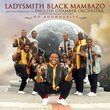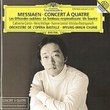| All Artists: Jean-Guihen Queyras Title: Bach: Cello Suites [2 CDs + DVD] Members Wishing: 0 Total Copies: 0 Label: Harmonia Mundi Fr. Original Release Date: 1/1/2007 Re-Release Date: 10/9/2007 Album Type: Import Genre: Classical Styles: Chamber Music, Historical Periods, Baroque (c.1600-1750), Classical (c.1770-1830), Instruments, Strings Number of Discs: 3 SwapaCD Credits: 3 UPC: 794881848126 |
Search - Jean-Guihen Queyras :: Bach: Cello Suites [2 CDs + DVD]
![Bach: Cello Suites [2 CDs + DVD]](https://nationalbookswap.com/cd//l/99/0799/6160799.jpg) | Jean-Guihen Queyras Bach: Cello Suites [2 CDs + DVD] Genre: Classical
|
Larger Image |
CD DetailsSimilarly Requested CDs
|
CD ReviewsExcellent 'step-springing' period Bach Cello Suites GTS | U.K. | 07/12/2008 (5 out of 5 stars) "This was played for me in my local classical CD store and that was it: I was hooked. When I then saw it in my local high-street national chain on sale at a ridiculous price I walked off with it like a kid at Christmas. Everyone who has heard the opening strains has said "That's fast", to which I have singularly replied "Yep - great isn't it?". And they have all remembered I'm a period enlightenment nut, and gone "Of course". It has everything to recommend it, this recording, from exquisite technique and musicianship, to ear-pricking boldness, gusto and courage, to a wonderful space around the recording that gives an atmosphere of elegance without being austere, reserved or removed. This could at once be in a great hall of kings, or in a little front room of a village cottage. Either which way, it really fills the room with a presence and spritely-ness that commands attention and bestows a great big smile. Queyras' recording had the misfortune to emerge at the same time as, and therefore under the blanket approval of, the admittedly great Steven Isserlis recording (yes, I love that one too). For that Isserlis set there was much media interest in how Isserlis had held off the Bach, made/waited himself ready, studied the pieces carefully, and identified (amazingly sombrely, given his findings) the dance rhythms and elements as the core of the works. (Doubtless this was highlighted because the record company / artist probably pushed it that way as a way of establishing an originality to justify another Cello Suites, as if any talented professional cellist needs the "contributing something new" clause or excuse to attempt on disc what is the pinnacle of their instrument's existence!!!) Isserlis' / Hyperion's recording certainly illuminates those dance rhythms, performing them rhythmically and excitingly, musically more alive than the sombre verbal/written annunciations of their presence was. However, Queyras / Harmonia Mundi offer(ed) no such reasoning for the recording's existence, and yet the dance rhythms are definitely their, perhaps even more so than with Isserlis. This recording is very much alive with them, and to them, and it resonates with a realness as a result. It's a dancing with a certain gentility, nothing raucous or base about it, but with a likeable robustness and positive forwardness that inspires both confidence in the artist's ability and consideration, and a reflection on the life and purpose of the pieces, from their gestation to their present incarnations. Just as I was beginning to despair for great readings of Bach's Cello Suites at present, and had recently delved back to discover the great readings of Pierre Fournier and Janos Starker (and finding I didn't like Rostropovich's rather clumpy and over-bearing fatherly heaviness as much as the reviews and reputations said I should like it), I am absolutely delighted to have two outstanding arrivals in the shape of Isserlis (which I knew would be great) and even more so Queyras (which I knew nothing about), which have reinvigorated my love of these works. I would also put in this echelon of new interpretations worthy of recommendation, those by Anne Gastinel, although I'm not sure how many will be so easily encouraged towards her's as towards Isserlis (easy to encourage towards) or Queyras (hopefully not too hard!). Isserlis uses gut strings and an instrument of appropriate age, and a great amount of "period" technique, attitude and approach, though is not definitively a "period" recording; Queyras is such; and Gastinel is "modern". All are very much worth investigation; all reaffirm the brilliance of Bach, of the pieces, and the existence of cellists capable of surmounting these heights; Queyras might just, for me, have climbed the hardest, fastest and best. Pass this by at your peril!" Excellent Joaquim Tarinas | Barcelona, Catalonia, Spain | 11/15/2007 (5 out of 5 stars) "I'm from Europe. My comment will be short. This is one of the top-10 CDs on Bach since it has been released (one or two months ago). Give it a try (it would be nice if you can hear good samples in an acceptable music set). In my opinion this recording of the cello suites is the among the best together with the ones by Pablo Casals, Yo-Yo-Ma and the rare and dificult to find by the swiss cellist Esther Nyffenegger. Very good sound, it's Bach and it has a dancing mood." Exceptional Recording l'auditeur | Orange County, California | 02/18/2009 (5 out of 5 stars) "It's true that these suites have been frequently recorded. But it's with good reason! Bach's work surpasses all others in its capacity to be plumbed, developed and re-imagined and displays unrivaled excellence and elegance on every compositional level. There is so much to be developed and highlighted in these works, a lifetime of performances may only scratch the surface.
It's also true that many have recorded these suites despite having nothing new to say and often possessing less than admirable technical skill, but since Casals they have figured at the heart of the cello repertoire, and every cellist is eager to conquer them. Each suite is difficult in it's own way, and the fifth and sixth suites are rather notorious for their formidable technical hurdles. It's rare to hear an individual who exhibits a true mastery over any given suite, much less the whole set. Queyras is that rare individual. And not only does he execute the technical demands of these suites with astonishing perfection and grace, but his interpretation brings something totally new to the table. He discusses in the liner notes a sense of phrasing which--respecting the contrapuntal nature of these works--treats melodic lines less like vocal song and more like spoken conversation. He executes them this way, deftly shifting his coloring of each phrase to bring out oft-hidden exchanges between voices to a startling and extremely pleasing effect. Queyras infuses each suite with an individual character by giving to each one a unique set of timbrel colors. I can't say I've ever encountered such an approach in other recordings, but at the same time, I don't think I've encountered another cellist able to draw so many different types of tone colors. Some of this may be attributed to a unusually rich-sounding cello (it possesses an extremely rich bottom end that literally growls in the scordatura tuning of the fifth suite) along with an exceptionally expressive and controlled bow technique. He even ornaments beautifully! This is an unusually tremendous set of recordings, both technically and musically. Whether you like his interpretation or not, one cannot argue but that each note has been meticulously considered and that his technical skill is second to none. This is a set that belongs in everyone's library." |

 Track Listings (18) - Disc #1
Track Listings (18) - Disc #1




